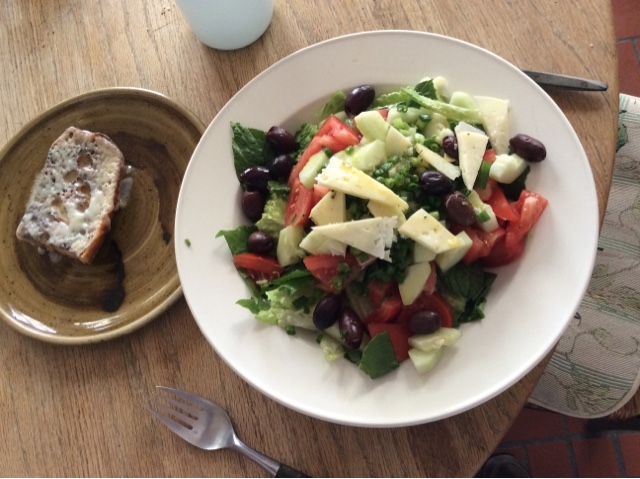December 2, 2015 Breakfast – Biodynamic Granola, Lunch – Salad, Dinner – PPI Split Pea and Ham Soup and making Posole
I intended to ride my bike today for the first time in a week, since I found out yesterday that my arm was not fractured and because the temperature was expected to approach 50 degrees without any wind, so I ate breakfast. I filled a bowl full of pineapple and Orange salad and the accumulated juices into a bowl and the added a handful of granola (Sprouts Market), a couple of spoonfuls of Kirtland Greek Yogurt and filled the bowl with mango nectar. I call this combination biodynamic granola, because that is what I saw granola named in a super market in Puerto Vallarta 15 years ago, when I came up with this combination of tropical fruit salad (usually mango, pineapple, and orange and lime juice), fruit flavored LaLa yogurt, “biodynamic” granola, and fruit juice.
At noon I wanted to keep things very clean and simple so I made a salad of romaine lettuce, Kalamata olives, a cubed vine ripe tomato, some cucumber, three minced green onions, and some sliced P’tit Basque cheese, which I also used to make an open faced cheese sandwich.
I had seen in the advertising brochure for Ranch Market onions on sale today for 4 lb. for $.99 and since we needed onions, I went to Ranch Market after lunch. I bought about 5 lb. of brown onions, limes, Latin Crema for $1.79/lb., and then saw that a huge 108 oz. can of hominy was on sale for $2.99. I have been having a hankering for Posole since the weather became frigid and I read in my book club selection for this month “Mayflower” that the Pilgrims ate a lot of hominy, as they adapted their food tastes to the indignant and ubiquitous food crop of the Indians, corn. The reason why they ate a lot of hominy is because dried corn kernels can be stored indefinitely and then turned into hominy by soaking the dried kernels in lye and water, which is the first food product derived from dried corn and requires no further processing, such as grinding and baking.
I then went to the meat department and bought a 3.64 lb. package of thinly sliced pork chops for $1.29/lb., so under $8.00 I was able to make a large pot of Posole. I also bought 2 cucumbers (5 for $.99) and three tomatoes at 2 lb. for $.99 to make Tzatziki and a cucumber, onion and tomato salad for the racks of lamb I had bought yesterday at Sprouts.
I refer to this form of shopping for menus in the future as longitudinal meal planning.
I napped for an hour and the rode from 4:00 to 5:00 and when I returned Suzette was home. We decide quickly to eat bowls of the split pea, ham and barley soup Suzette had made a few days ago.
At 5:30 I started making the Posole by cleaning the large pot I use for Posole, which was still outside on the patio, filling it half full with water, heating the water on the double ring burner on the stove to quickly heat the water and rinsing and adding the pork chops to the water. I then diced one of the onions I bought today and threw that into the pot plus about 3 Tbsp. of Mexican oregano, plus about eight to ten cloves of garlic. When the pork chops were cooked, I removed them and slices them into cubes and returned the chopped pieces and bones to the pot. I the opened the can of hominy and rinsed it in cool water and added it to the pot. I moved the pot to the burner with the smallest gas ring and turned the gas down to its lowest setting to simmer the Posole.
Perhaps the label attracted me; the Spanish translates as "Corn Posole Maker" In Mexican Spanish. In Mexico Posole is spelled with a "z" instead of an "s" as in New Mexican Spanish, so in two words the label is telling Mexican folks, "This the stuff that will make your great Mexican dish, Pozole." How can anyone resist the urge to buy a large can that will help them make their Pozole. I felt psychologically like I was halfway finished with making the Pozole as soon as I had picked up the can.
Suzette then went to the basement and fetched a quart freezer bag with six or seven green chiles that had been roasted and frozen by her kitchen staff in Los Lunas last year. We thawed the chiles by run warm water over them and the Suzette peeled the chiles an de-seeded them and added the cleaned chiles to the pot of Posole.
Suzette then heated the Split Pea Soup and toasted four slices of the new French baguette and we enjoyed bowls of the soup, which had become much more integrated and creamier in its texture as it sat in the fridge in the garage for the last two or three days.
At 6:40 I went to meditate and when I returned home the Posole pot was still on a low simmer. I turned off the heat, said hello to Suzette, who had gone to bed, and, rather than go to the basement to look for the cover for the pot, covered it with a sheet of aluminum foil and carried it to the garage and placed it only the concrete floor, as the temperature was below freezing.
I'm sure we will be eating Posole for weeks for the same price as two bowls of Posole at a restaurant. Posole seems to be a perfect example of elegantly simple peasant cuisine in New Mexico.
I am also proud to be adapting our diet to that of the indignant natives, just like the Pilgrims.
Bon Appetit


No comments:
Post a Comment